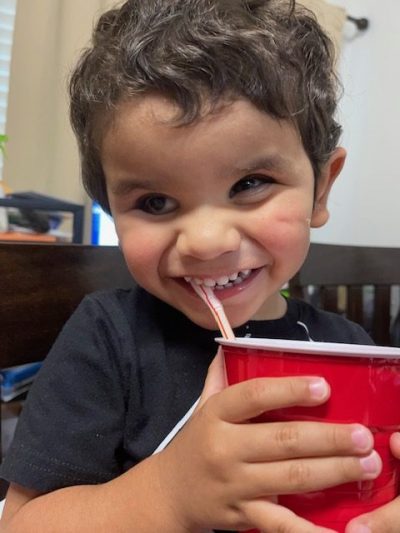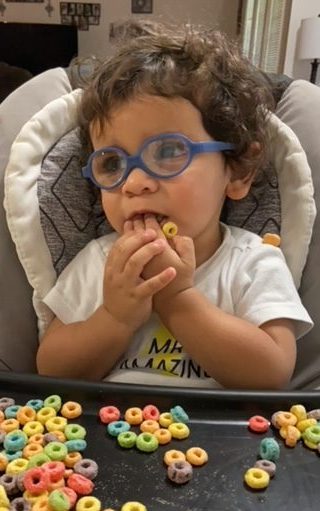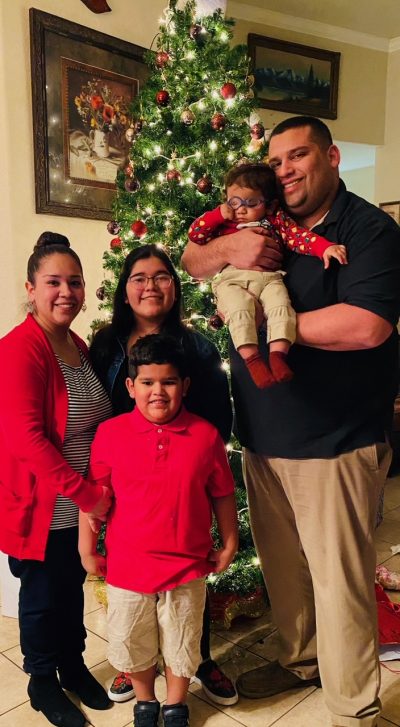From Uncertainty to Understanding for Family of 4-year-old Living with LCA1 GUCY2D
Desirae Potts breaks into tears when she recalls the first time a doctor said her infant son James had a disease she’d never heard of – Leber congenital amaurosis, known as LCA.
“I had no earthly idea what she was talking about. I left that appointment, I remember feeling so confused and so sad,” the 33-year-old mom said.
The doctor didn’t or couldn’t give Desirae and her husband, Robert, any information about LCA because the doc didn’t know a thing about the rare inherited retinal disease.

A smiling James Potts
“I had to grieve the life that my son would have had,” she said. “But I also wish that I knew then what I know now, that is: Whether he could see or not, I have a bright light!
“He’s so amazing, I couldn’t imagine him any other way and I wouldn’t change it if I could.”
She thought about the best way to bring up her son.
“I quickly learned the best way to raise him would be to raise him like my sighted children. He is the most resilient and bright young man. I know he is so smart. He amazes me every day.”
Mom becomes nurse to better help her son
James was 10 months old when his parents learned their younger son’s genetic diagnosis: LCA1* caused by a mutation in his GUCY2D gene.
About the same time, Desirae kept listening to doctors talking over her head and decided to become a nurse.
“I wanted to help him with my knowledge. It definitely helps because I have more medical knowledge than I did before. I understand what the doctor is saying. The doctors used all these words I didn’t know, and I was scared that I didn’t know.”
She began nursing school in James’ first year and earned her nursing degree about a year and a half ago. James is now 4.
“I’m not as worried now, and I know what to do in certain situations.”
James goes to school for the full day in an integrated classroom at the same school as his older brother, 9-year-old Robert. His older sister, Ariona, is in high school.
Their mom is the school nurse at the four middle schools in the district of their South Texas coastal city.
Keeps informed of LCA1 GUCY2D research
Desirae knew something wasn’t right with her baby’s vision at 2 months when he didn’t track objects or light. At 4 months, an ophthalmologist prescribed glasses, but they didn’t help.

James wearing his “Mr. Amazing” shirt
After the initial retinal disease diagnosis, James received his confirmed genetic diagnosis 6 months later at Baylor College of Medicine by Richard A. Lewis, MD, MS, Professor of Molecular and Human Genetics at the Houston medical school.
Annually, James visits John T. Stout, MD, PhD, who keeps the family informed of research in the LCA1 GUCY2D space. Dr. Stout specializes in retina/macular and retinal vascular diseases at Texas Children’s Hospital. His current research projects include human gene and stem cell therapy for proliferative and inherited ocular disease, retinal disease genotype-phenotype correlation, and intraocular angiogenesis, the formation of new blood vessels from the existing vascular tree.
LCA accounts for 5 percent of all retinal dystrophies and 20 percent of blindness in school-age children.
LCA1* is one of the most common of the more than 27 identified forms of the rare inherited retinal disease, affecting about 20 percent of people who live with the disease.
Some favs: Bagels and Daniel the Tiger
James received early-intervention therapy, and orientation and mobility therapy during his first years. He also sees a speech therapist at school and a developmental specialist in town.
Right now, his favorite food is bagels and butter. And he absolutely loves music and Daniel the Tiger, a spinoff from Mr. Rogers Neighborhood, where he sings songs about learning, and growing, and what to do with feelings.
James does not yet have words to describe his sight, which makes it hard to explain what he can see, although his mom believes he has light perception.
James’ vision is a family affair
“It not only affected him, but it also affected all of us,” Desirae said. “We all had to adjust and learn how to make things in a way that he could do things on his own and foster his independence.”

The Potts Family: Robert wearing red shirt in front, with L-R: Mom Desirae, Ariona, James, and Dad Robert
Ariona, James’ 17-year-old sister, nurtures her little brother, with mom adding, “She’s the closest thing to me he can get. She’s very, very helpful.”
Robert was 5 when James was born.
“He didn’t quite understand what’s going on and how to be accommodating to his brother. We definitely had to inform him.”
Desirae is concerned about James pressing or rubbing his eyes, a symptom of LCA called oculodigital reflex. While the doctor said the reflex is normal, she is worried the action may cause harm. She tries to keep him occupied.
“I try very hard, but James is maybe the most headstrong person I have ever met in my entire life. If you tell him to do something, he will do the complete opposite. So, I tell him, ‘Don’t let me see your eyes,’ even though I don’t want him to defy me.”
James loves to explore and see with his hands.
“We don’t use the word ‘blind.’ We prefer to say that he sees with his hands. We don’t say ‘blind’ or ‘visually impaired.’ We do not want him to think that that would define him.
“That was something I had to teach both of our children, my husband, and all of our family. Some relatives are still in denial. We don’t put him in a box. We let him explore and have the same toys as his brother and sister,” she said.
“We try to have everyone stay on the same page to help build his confidence. Like it’s normal for him that he sees with his hands.”
*Next month, our Hope in Focus LCA Family Conference includes a presentation from an LCA1 GUCY2D researcher. The June 23-24 conference is in Indianapolis.
